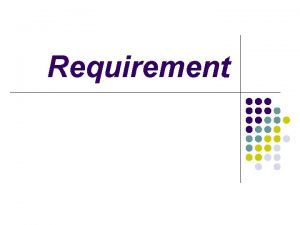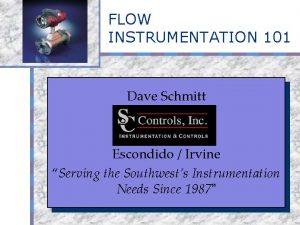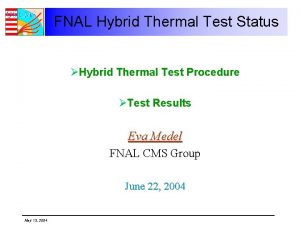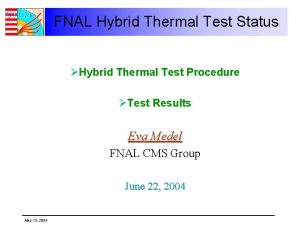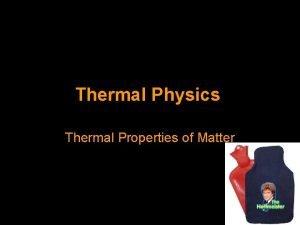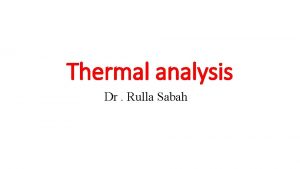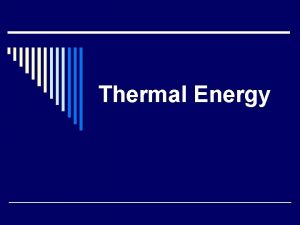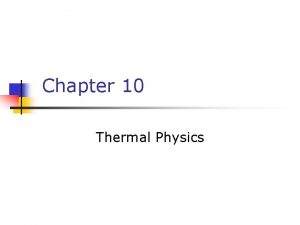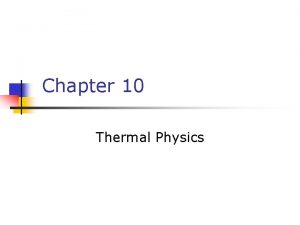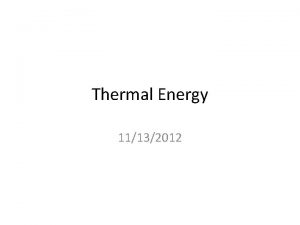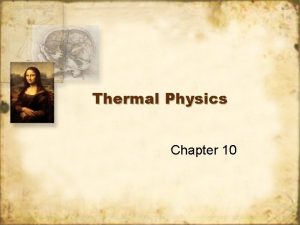Rationale for Selected MILSTD1540 E Thermal Test Requirement












- Slides: 12

Rationale for Selected MIL-STD-1540 E Thermal Test Requirement John W. Welch The Aerospace Corporation TFAWS 2012 13 -17 August 2012 © The Aerospace Corporation 2008

Introduction • MIL-HDBK-340 – guidance for planning and executing ground testing of military spacecraft based on MIL-STD-1540 requirements – Update of MIL-HDBK-340 in work providing justification and rationale for test requirements and parameters • Four specific test parameters reviewed in this presentation – These four selected based on their relative importance in meeting test objectives and frequency requests for clarification and discussion • Thermal uncertainty margin • Unit-level thermal vacuum test exemption criteria • Unit-level thermal test temperature range and number of cycles • Vehicle-level thermal test temperature range and number of cycles 2

Thermal Uncertainty Margin • Temperature margin between worst-case analytic predictions and acceptance temperature range – – • Accounts for inherent design uncertainties Passive thermal control (conduction/radiation): ± 11°C temperature margin Active thermal control (heaters): 25% control authority Cryogenic systems: gradation of temperature and power margins The ± 11°C thermal uncertainty margin is the result of extensive comparisons between preflight predictions and flight measurements – 95% of flight temperatures within ± 11°C of temperature predicted by correlated analytic thermal models • 1971, 1987, 2006 • US military, NASA, commercial, European flight data reviewed 3

Thermal Uncertainty Margin Flight Data • • High priority military program launched in 1994 showed an required margin of 10. 5°C ESA (Thales Alenia) flight data from 1990 s across several programs indicated a 95% confidence level required a 11. 5°C margin – Recommendation for a 90% probability of compliance at ± 10°C – Recommendation for a 95% probability of compliance at ± 12°C • ± 11°C margin shown to be necessary to ensure high confidence that flight temperatures will not exceed predicted values for low-risk, high-priority space programs Welch, J. W. , “Assessment of the Thermal Uncertainty Margin from Flight Data Comparison with Thermal Model Predictions, ” Proceedings of the 24 th Aerospace Testing Seminar, April 2008 4 ± 11°C

Unit-Level Thermal Vacuum Test Exemption • MIL-STD-1540 E provides criteria to assess whether an electronic unit is sensitive to vacuum conditions – When a unit is proven to be vacuum insensitive, the unit-level thermal vacuum test may be waived and all unit-level thermal testing performed in an ambient thermal cycle environment – Criteria serve as an example for consideration for determining vacuum-sensitivity • Proven flight heritage, design and performance robustness, thermal design margins, etc. – Applicable to electronic units only • Mechanical and electro-mechanical units require TV environment to demonstrate performance in a flight-like environment • TC testing not required for mechanical units per MIL-STD-1540 E – Applicable for acceptance units only • Protoqualification and qualification units require TV environment to demonstrate vacuum-insensitivity for any unit of new design 5

Unit Thermal Test Requirements for Electronic Units • MIL-STD-1540 E Requirements – Temperature Ranges • Acceptance: • Protoqualification: • Qualification: – Duration • Acceptance: • Protoqualification: • Qualification: 6 maximum predicted or -24°C to +61°C 5°C beyond acceptance or -29°C to +66°C 10°C beyond acceptance or -34°C to +71°C 10 TC and 4 TV (14 cycles total) 23 TC and 4 TV (27 cycles total)

Establishing Unit Test Temperature Levels 7

Rationale for Unit Test Temperature Range • Acceptance temperature range – Rationale for the ± 11°C thermal uncertainty margin already discussed – 85°C range based upon part manufacturer’s practice for screening – 50°C maximum model prediction was the result of an industry survey of spacecraft manufacturers • Qualification temperature range – The qualification margin was the result of consulting unit manufacturers and aerospace contractors about common practices for qualifying hardware design – Agreement was reached that an additional 10°C margin should be included in the acceptance temperature range for qualification • Protoqualification – Compromise in the qualification margin where unit design test objectives are still met, but on flight hardware – Margin is half of the qualification margin (5°C) 8

Rationale for Unit Thermal Test Cycles • • Basis of 14 and 27 cycles is a continued emphasis of environmental stress screening (ESS) at the unit level were defects are more perceptible and less costly to repair or replace Test effectiveness data as a function of cycles is difficult to obtain and many times the results are subjectively interpreted One study, based upon the work reported in MILHDBK-344 and Aerospace data 1. 00 0. 95 Test Effectiveness • Test effectiveness at 27 cycles for qualification testing = 99. 8% 0. 90 Qualification Protoqualification Acceptance 0. 85 Test effectiveness at 14 cycles for qualification testing = 94. 7% 0. 80 0. 75 0. 70 0 2 4 6 8 10 12 14 16 18 20 22 24 Cycles Welch, J. W. , “Investigation of the Relative Importance of Thermal Test Parameters as Specified in MIL-HDBK-344, ” Proceedings of the 25 th Aerospace Testing Seminar, October 2009. 9 Wright , C. P. , “Test Effectiveness of SMC-S-016 Unit Acceptance Thermal Testing, ” Proceedings of the 26 th Aerospace Testing Seminar, March 2011. 26 28 30

Vehicle TV Test Requirements • • MIL-STD-1540 E Requirements • • • 10°C beyond acceptance temperatures for 8 cycles 5°C beyond acceptance temperatures for 4 cycles maximum predicted temperature range for 4 cycles Unlike unit-level test temperatures, there is no default temperature range at the vehicle level • • • 10 Qualification: Protoqualification: Acceptance: Primary purpose of vehicle-level testing is not ESS, but rather demonstration of performance requirements in a flight-like environment Acceptance temperature range includes the ± 11°C thermal uncertainty margin at both hot and cold temperature levels • Heater power typically keeps cold test temperatures at flight values • Use of thermal zones in which only one location within a hardware area achieves the test temperature means that most areas of the vehicle will not see the test margin at test temperatures • Emphasizes the importance of rigorous unit-level test program Protoqualification and qualification test temperature ranges use the same margins as discussed for unit-level testing

Vehicle TV Test Requirements - Cycles • Vehicle-level cycles require the same number of cycles for protoqualification as required for acceptance • • Trend is different than seen at the unit level where protoqualification cycles are the same as qualification cycles • Result of a goal for accruing more screening at the unit level of assembly • At the vehicle level, performance verification is primary emphasis, not ESS Four cycles for acceptance and protoqualification is consistent with industry practice SP FT SP – Specification Performance Test (Full Functional) FT – Functional Test (Abbreviated Functional) Temp. FT Ambient FT SP FT FT SP Time First cycle: Verifies initial performance and detects early defects 11 Middle cycles: Adds thermal stresses to hardware and interfaces Final cycle: Demonstrates flightworthiness, assesses integrity after thermal stresses, and provides trending data to first cycle

Conclusions • • • MIL-STD-1540 E was written to ensure that high-priority military spacecraft are tested to levels and environments that increase the likelihood of mission success MIL-HDBK-340 provides the application guidelines and rationale for test parameters and procedures specified in MIL-STD-1540 E Testing to MIL-STD-1540 E requirements over the past decades has demonstrated its value in support of military programs: – Identifying design workmanship problems early in the build process – Providing realistic flight environments where performance and functional requirements can be verified – Demonstrating flight-worthiness 12
 Requirement adalah
Requirement adalah Thermal mass flow meter straight run requirement
Thermal mass flow meter straight run requirement Chapter 5 thermal energy answer key
Chapter 5 thermal energy answer key Thermal transfer vs direct thermal printing
Thermal transfer vs direct thermal printing What is selected response
What is selected response Formuö
Formuö Typiska drag för en novell
Typiska drag för en novell Nationell inriktning för artificiell intelligens
Nationell inriktning för artificiell intelligens Vad står k.r.å.k.a.n för
Vad står k.r.å.k.a.n för Varför kallas perioden 1918-1939 för mellankrigstiden?
Varför kallas perioden 1918-1939 för mellankrigstiden? En lathund för arbete med kontinuitetshantering
En lathund för arbete med kontinuitetshantering Personalliggare bygg undantag
Personalliggare bygg undantag Tidbok för yrkesförare
Tidbok för yrkesförare
